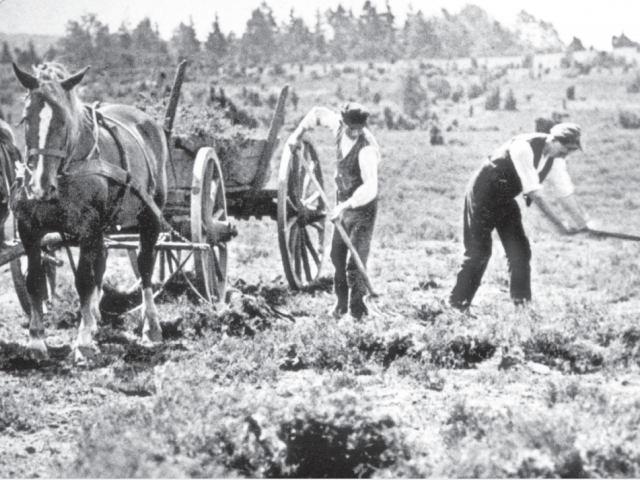Plaggen Agriculture
Drudgery on the Esch
You may have come across the word Esch as part of some street names in the Osnabrück area (e.g., Mühleneschweg, Römereschstrasse.) This word has its origin in a centuries-old form of farming that was unique to this part of the world and intensively shaped large parts of north-west Germany – Plaggen, which is a kind of sod management or targeted fertilization. Well-rooted pieces of heather or forest soil (plaggen) were drudgingly dug up and used as bedding in the stable. These plaggen or sods were thereby mixed with animal waste and partly enriched with kitchen waste and ash. This mixture was finally spread out onto the fields, forming a very fertile soil layer called Esch. The so-called Plaggenesch was born. With this form of farming, the farmers countered the region's barren sand and loess soils that had been shaped by the Ice Age. The beginnings of this sod agriculture go back to the 12th/13th centuries here in Germany. The possibility of targeted fertilization was revolutionary at that time. In addition to major changes in the landscape, sod fertilization, which was practiced in places up until the 1930s, also had an impact on regional culture and social life.
From an ecological point of view, however, sod agriculture also brought with it visible disadvantages – to get one acre of fertile Plaggenesch, one had to dig up the sod of five to ten acres of forest land. As a result, the sandy soil of the forest, which was already poor in nutrients, became even more impoverished. This in turn resulted in a decline in forest areas and an expansion of heathland. The grazing grounds deteriorated and there were regular sand drifts and dune formation in the lowlands.
Why is this an intangible cultural heritage?Knowledge and customs related to nature form a completely separate category of intangible cultural forms. The interaction between people and the environment plays an important role here. Although sod fertilization is a traditional form of farming that is no longer used directly today, it has shaped our region for generations and is still reflected in our landscape today. In this respect, it embodies an intangible cultural asset that also provides the region a bit of its identity.
Incidentally, we also owe the archaeological finds from the legendary Varus Battle now in the Kalkriese Museum and Park to the Plaggenesch that was there. It preserved the evidence of bygone times, while nothing could be found in the surrounding modern fields.
Because sod agriculture is no longer used in this form today, it does not officially count as an intangible cultural heritage; however, this traditional way of farming has left a lasting mark on the cultural landscape of the TERRA.vita region.
Where can I discover sod agriculture in our region?
Upon close inspection, you can discover several areas in the TERRA.vita Nature and Geopark where sod farming was practiced. You can find particularly clear examples of a still existing Plaggenesch along the Eiszeit-Entdeckerpfads (Ich Age Discovery Trail) near Bippen or on the TERRA.track Wacholderhain (TERRA.track Juniper Grove) near Merzen. The juniper grove itself is a relic of the heather cultural landscape that was widespread in the Middle Ages. The landscape can be optimally explored on the Barefoot and Information Trail.
Anyone who is interested in the tradition of sod agriculture and would like to look into the cultural history of our region is cordially invited to visit one of the above-mentioned places. But that's not all: a Plaggenesch Center is being planned at the Lechtinger Mühle in Wallenhorst.


